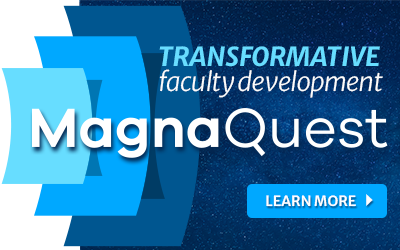This article first appeared in Academic Leader on December 14, 2020. © Magna Publications. All rights reserved.
With the coronavirus pandemic affecting every aspect of our lives, now is the time for us to learn from each other. While Allegheny College has the advantage of being small, private, and located in rural Pennsylvania, we believe the lessons we learned over the past nine months are transferable to institutions of all sizes, forms, and locations hoping to reopen for spring.
Below are six important lessons all academic leaders can adopt to move any institution forward, whether in times of stress and crisis or prosperity and success.
1. Establish an iterative planning process
As news of the global pandemic began to spread, out of an abundance of caution, Allegheny College modified operations and temporarily conducted all classes in the spring 2020 semester through remote instruction. Once we transitioned to fully remote learning, we began planning how to assess the risks and benefits of opening for the fall 2020 semester. As we navigated the ever-changing public health situation, I formed 12 campus-wide implementation groups of administrators, staff, faculty, and students that took on the job of crafting a document that laid out our guiding principles and our rationale for reopening. That draft was then shared with a number of alumni and area experts who provided multiple rounds of feedback and constructive comments in an open and iterative fashion until it had enough structure and clarity to be made public.
The guiding principles included
- prioritizing the health and physical and emotional safety of our campus community and our local community through meaningful partnerships;
- maintaining our commitment to equity and diversity and to equal access for all our students to the academic, social and wellness (physical and emotional) resources available at the college;
- the ability to create a comfortable environment for students to learn, faculty to teach, and staff to work; and
- maintenance of the strong community ethos for which Allegheny College is known.
Our rationale for reopening included the advantages of our rural location; our size (about 1,400 students anticipated to be on campus and 500 faculty and staff); our community spirit; our faculty experts in such relevant areas as global health, microbiology, sustainability, community, and justice; and our community of liberal arts–trained faculty and students who think flexibly and adaptively through interdisciplinary lenses, whom we felt confident would creatively approach the challenge of remaining open.
2. Any planning process must be collaborative . . . but only to a point
The complex overlay of the global pandemic, racial unrest, and financial crisis meant there was no single expert able to solve the issue or navigate through it alone. Early on I surrounded myself with trusted, accomplished experts, including alumni in public health, local medical experts, CEOs of hospitals and testing companies. I put out a broad ask to our trustees and our campus and local community to connect me with anyone willing to share advice, and I spent hundreds of hours talking to everyone I could find. This led to the creation of our innovative Allegheny College Health Agency (ACHA) to fill the gap in clinical and public health services in Crawford County. This high-level group has advised me and guided the college’s reopening. It is comprised of experts in epidemiology, emergency medicine, nursing, mental health, and risk management who meet every other week by Zoom. The biggest takeaway to share, especially for administrators on a small, remote campus: If you don’t have experts on campus, go out and find them.
Beyond ACHA, our campus-based planning process was very inclusive. Just as we teach our students to break down big, looming academic assignments, similarly we divided our planning process among our 12 working groups to focus on every aspect of the reopening. The breadth of membership ensured that every aspect was being considered from as many different perspectives as possible.
In the end, though, as with any difficult decision, a clear leader has to step up and, alone, make the big decision of how to move forward. In early August, as our reopening approached, fear and anxiety took hold among our staff, parents, senior leaders, and faculty. Backed by our guiding principles and rationale, I made the decisive move to proceed with the strategy we prepared, based on my confidence in the strong planning process we had undergone. In the end, the responsibility for our students, faculty, and staff and the institution’s future fall squarely on me, and so I stepped up and made the best-informed decision I could, which turned out to be the right one.
3. You can never be communicative and transparent enough
Communicate, communicate, communicate, and you will still be told you are not communicating enough. Over our months of planning, we put out frequent messages, distributed videos, held town halls and responded to inquiries from our community, updating everyone as often as possible on all decisions we were making. And yet, as the reopening approached and anxiety increased, we were still accused of a general lack of transparency. In the end, a faculty member gave me a great piece of advice: “We may not need to know exactly what sausage is made, but you need to constantly tell us that there is a sausage being made!” It was an important reminder that if you are not pushing out your own narrative constantly, you are giving people the vacuum in which to create a narrative of their own—which often is more negative than the real one.
4. Don’t hesitate to be creative (or, never let a good crisis go to waste)
My best advice for anyone trying to tackle any overwhelming global, complex challenge is to take a step back and think big. Don’t solve merely for the problem in front of you but instead for the bigger vision you are hoping to achieve long-term. A good example is our academic calendar for 2020–21. Our planning was driven by my requirement that we not just “adapt” to COVID-19 protocols but use this moment as an opportunity to be creative.
We encouraged our faculty and curriculum committee to develop a brand-new Winter Intensive Study Module—a remote January module that includes fresh multidisciplinary learning and teaching opportunities while at the same time reducing risk, to the extent possible, during the peak cold and flu season (mid-November through early February). Faculty have already enthusiastically embraced this module as they plan for the next academic year, and I believe it will remain as a creative interlude of our academic calendar for years to come.
5. Be compassionate
The compounded mental health challenges of the pandemic, financial crisis, and racial unrest create trials that in many ways are more difficult than the physical or logistical issues we face. If there is one area in our early planning on which we had not focused sufficiently, it was the psychological impact of these intersecting crises and the support our students, staff, faculty, and parents would require on an ongoing basis.
The heavy weight of seclusion quickly became an arduous challenge for students and one we had to address quickly. We increased our outreach to sick or quarantined students from our counseling center. We provided activity bags for those in quarantine or isolation and arranged daily check-ins by medical professionals, residence life staff, and others.
We saw a dramatic uptick in counseling appointments throughout the entire semester, especially in the early weeks of our campus quarantine. Unsurprisingly, the emotional trauma of an abnormal semester takes its toll. As a parent whose own child was experiencing the same isolation and anxiety far away, it was helpful for me to remember to wear that compassionate, parental hat in addition to my administrator’s hat when interacting with all of our constituencies.
6. Keep your focus on the bottom-line goal of health and safety, of the future of your institution, and of what you feel is right
Many people—yourself included—will question your decisions every day, usually in very unpleasant ways. Keep returning to your guiding principles and rationale, do a daily gut-check (along with your daily health screen!), and keep moving forward one step at a time. Know that this is going to be harder than you ever imagined, and don’t take offense at learning that some people want you to fail, mainly so they can show they were right all along. Trust your moral compass and your instincts, but also constantly check them with your team of experts. Leading your institution through overlapping crises is not for the faint of heart. But in the end, it is all toward keeping people safe and providing equal opportunities for students’ education, social mobility, and growth long into the future.
Hilary L. Link, PhD, is the first female president of Allegheny College, one of the nation’s oldest and most innovative multidisciplinary colleges. She previously served as dean of Temple University Rome and vice provost at Barnard College. She received her doctorate in Italian language and literature from Yale University.



